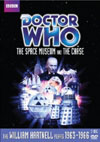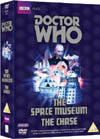DVD Extras include:
The writing isn't much on character or dialogue, but it is fast paced, whisking the audience away from each time and place before any of it becomes too boring. Episode one begins with some historical snippets, including an all-right clip of the ancient Beatles performing "Ticket to Ride". Vicki's historical point of view of them gets more appropriate with each passing year. Sadly, it seems not everyone gets to see this part of the episode, due to overcomplications with Beatles music / video rights. Apparently, PBS re-runs include this bit. Store-bought VHS video all over the world did not. Word is, DVD versions have it back in, IF you can get the European Region 2 copy, and IF you have an appropriate player and TV monitor for it. North Americans may still be expected to shell out for a copy that leaves it out - and who knows how butchered the audio commentary will be that talked over this clip as well. Episode Two's title - "The Death of Time" - seems to have nothing whatsoever to do with anything in the episode. I think that's all I'll say here to avoid possible spoilers. Come back and read the in-depth analysis version of this review after you've seen the story. In our director's defense, we have to give Richard Martin credit for giving us the FIRST example of the TARDIS dematerialization sound being REVERSED during a landing in episodes three and four. Nice one! All that remains is to lop off the final wheeze and add a thud, and you'd have the sound we all became accustomed to hearing throughout the 1970's and 1980's. The acting still remains cheesy throughout though. The tour guide's New York accent isn't bad, but somehow it's still obviously faked. The dialogue isn't very natural either - too much emphasis on sounding like a New Yorker, and not enough on saying something intelligent. Then we come to Peter Purves' debut as Morton Dill. I admire the way he can usually throw himself completely into a role with a lot of energy and make it watchable, but poor old Morton is scripted to go way over the top, so that's what you get. There are some better performances in the later half of episode three, not to mention a very atmospheric sequence, but many of the scripted interactions are pretty dull at this point. The same can be said of the early episode four sequences - as far as horror and suspense goes, the location and its characters are far too much of a badly-acted joke. I think it was a mistake to hide the true nature of both of these locations for so long. In the first one, not enough interest in the place is allowed to build until it is too late. Sir Ian Chesterton and the Doctor come up with some fascinating theories for the second location, which would support what they witness. All good. The actual revelation cheapens the whole sequence, and more considering the story as a whole. What we get for action here is pretty cheesy anyway, more mindless mayhem and running about. Some itchy cameraman had to readjust the frame of the TARDIS inlay shot, giving away the effect once again. At least we get plenty of drama out of some makeshift travel arrangements and the Daleks' increasingly devious plans. Simply by exercising his sole right to pilot the TARDIS, the Doctor has generally had more important things to do than any of his companions so far in this adventure. At long last, episodes five and six give us some excellent examples of Hartnell Heroism, which season two has sorely been lacking. A bit of "double trouble" provides interest for the episode, but it's not quite as easy to tell who's Who as you might think at first sight. And I think we have to give thanks to both Terry Nation for asking for this sequence and Richard Martin for delivering it, because this is so much better than the TV version of "The Massacre" (story no. 22), which tried in part to base itself much more heavily on a similar idea, and failed to come up with as entertaining or effective a sequence as what we get here. The Doctor's character also finally seems to shift towards the noble traits he would eventually become better known for. William Hartnell's the man in episode five. Thank you, Terry Nation, for finally figuring it all out! Episode five also has the best cliffhanger. Things are really looking up! Episode Six proceeds to be the most interesting of all during "The Chase". Although the model work shows up a bit at one point, the sequence remains interesting with scenes that double for exploration of the city and for first contact. A soon-to-be companion is introduced, bringing the main cast up to five, as Peter Purves switches to the role he will be most remembered for on Doctor Who. The scenes of Steven Taylor meeting the rest of the crew demonstrate that Purves is a much more sensible actor than he might have at first appeared, and Steven is quite a charming, friendly fellow. (On a PBS TV broadcast, Lionheart's episode six credits attempt to serve the entire story, and unfortunately Peter Purves is credited for Morton Dill again, with no mention of his more important role as Steven Taylor. Who does these credits? Don't they pay attention to the series?) The script has a big hole in its logic here.... but I'll save the spoilers. It doesn't do the story much damage anyway. Things begin interestingly enough when the five travellers tackle a major challenge, and Vicki's personal fears add extra tension. Sir Ian needlessly makes a real idiot out of himself at this point though, and it seems the whole thing is begging for more tasteful directorial choices once again. The worst part of episode six are the Dalek portrayals in the video studio. The so-called conquerors of the universe act like anything but here. This is too lame for forgiveness. However, the final battle on FILM is a VAST improvement. High energy is what is called for to keep the story moving, and there is plenty of it. Plus we get good, menacing, in-character performances here, so right on. Post climax, we get an important bit of emotional drama. The writing, acting and everything are generally really well done from here on. I was always particularly impressed by the creativity in the still photo sequence. I later learned that Douglas Camfield took those shots. Somehow, I'm not surprised.
ConclusionsAll in all, episode six is an action-packed landmark half hour, and the Doctor fares well in both the heroic and character departments. All things considered and balanced, an above average episode not to be missed. "The Chase" is definitely the best of Richard Martin's season two stories, and remains particularly gripping from the middle of episode four to the end.
This story has become available on DVD and VHS video. Click on the Amazon symbol for the location nearest you for pricing and availability:
Comments on this article are welcome. You may contact the author from this page:
|








